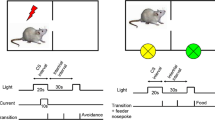Abstract
Two experiments, using mice, investigated the effects of preexposure to shock on subsequent bar-press-to-escape performance. Experiment 1 demonstrated the usual interference effect: Subjects exposed to escapable shock performed better than subjects exposed to no shock, who in turn performed better than those exposed to inescapable shock. In Experiment 2, a 2 × 2 × 2 factorial design compared groups that were preexposed to escapable or inescapable shock of 2- or 6-sec duration for either 60 or 180 trials. An interaction between number and duration of inescapable shocks was shown, such that it was possible to produce an interference effect with short duration shocks when a large number of preexposures was employed. This finding is congruent with a number of hypotheses which attempt to account for such interference effects, but is difficult to reconcile with simple motor inactivity or uncontrollability interpretations.
Similar content being viewed by others
Reference Note
LUBOW, R.E., ROSENBLATT, R., & WEINER, I. The confounding controllability in the triadic design for demonstrating learned helplessness. Unpublished manuscript, 1979. Available from authors.
References
ALTENOR, A., VOLPICELLI, J.R., & SELIGMAN, M.E.P. 1979. Debilitated shock escape is produced by both short- and long-duration inescapable shock: Learned helplessness vs. learned inactivity. Bulletin ofthe Psychonomic Society, 14, 337–339.
ANISMAN, H., deCATANZARO, I., & REMINGTON, G. 1978. Escape performance following exposure to inescapable shock: Deficits in motor-response maintenance. Journal of Experimental Psychology: Animal Behavior Processes, 4, 197–218.
ANISMAN, H., GRIMMER, L., IRWIN, J., REMINGTON, G., & SKLAR, L.S. 1979. Escape performance after inescapable shock in selectively bred lines of mice: Response maintenance and catecholamine activity. Journal of Comparative and Physiological Psychology, 93, 229–241.
BAKER, A.G. 1976. Learned irrelevance and learned helplessness: Rats learn that stimuli, reinforcers and responses are uncorrelated. Journal of Experimental Psychology: Animal Behavior Processes, 2, 130–141.
BRACEWELL, R.J., & BLACK, A.H. 1974. The effect of restraint and noncontingent preshock on subsequent escape learning in rat. Learning and Motivation, 5, 53–69.
BRAUD, W., WEPMANN, B.R., & RUSSO, D. 1969. Task and species generality of the “learned helplessness” phenomenon. Psychonomic Science, 16, 154–155.
CASPY, T., FROMMER, R., WEINER, I., & LUBOW, R.E. 1979. Generality of Us preexposure effects: Effects of shock or food preexposure on water escape. Bulletin of the Psychonomic Society, 14, 15–18.
COSTELLO, C.G. 1978. A critical review of Seligman’s laboratory experiments on learned helplessness and depression in humans. Journal of Abnormal Psychology, 87, 21–31.
GLAZER, H.I., & WEISS, J.M. 1976a. Long-term interference effect: An alternative to learned helplessness. Journal of Experimental Psychology: Animal Behavior Processes, 2, 201–213.
GLAZEK, H.I., & WEISS, J.M. 1976b. Long-term and transitory interference effects. Journal of Experimental Psychology: Animal Behavior Processes, 2, 191–201.
LUBOW, R.E., WEINER, I., & SCHNUR, P. 1981. Conditioned attention theory. In G. Bower (Ed.), The psychology of learning and motivation (Vol. 15). New York: Academic Press.
MAIER, S.F., & JACKSON, R.L. 1979. Learned helplessness: All of us were right (and wrong); Inescapable shock has multiple effects. In G. Bower (Ed.), The psychology of learning and motivation (Vol. 13). New York: Academic Press.
MAIER, S.F., & SELIGMAN, M.E.P. 1976. Learned helplessness: Theory and evidence. Journal of Experimental Psychology: General, 105, 3–46.
OVERMIER, J.B., & SELIGMAN, M.E.P. 1967. Effects of inescapable shock upon subsequent escape and avoidance learning. Journal of Comparative and Physiological Psychology, 63, 28–33.
SELIGMAN, M.E.P. 1975. Helplessness: On depression development, and death. San Francisco: W.H. Freeman.
SELIGMAN, M.E.P., & MAIER, S.F. 1967. Failure to escape traumatic shock. Journal of Experimental Psychology, 74, 1–9.
Author information
Authors and Affiliations
Additional information
This article is part of a thesis submitted to Bar-Ilan University in partial fulfillment of the requirements for the Ma degree by the first author under the direction of the second author. The research was supported, in part, by a grant to the second author from the Israel Commission of Basic Research.
Rights and permissions
About this article
Cite this article
Caspy, T., Lubow, R.E. Performance Decrement Following Shock Preexposure: The Effect of Number and Duration of Escapable and Inescapable Shocks. Psychol Rec 31, 183–194 (1981). https://doi.org/10.1007/BF03394734
Published:
Issue Date:
DOI: https://doi.org/10.1007/BF03394734




